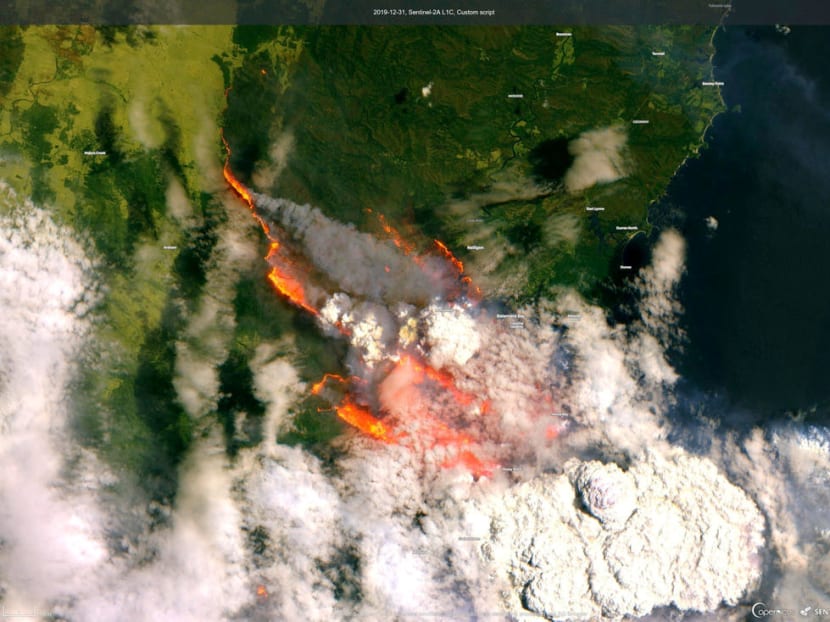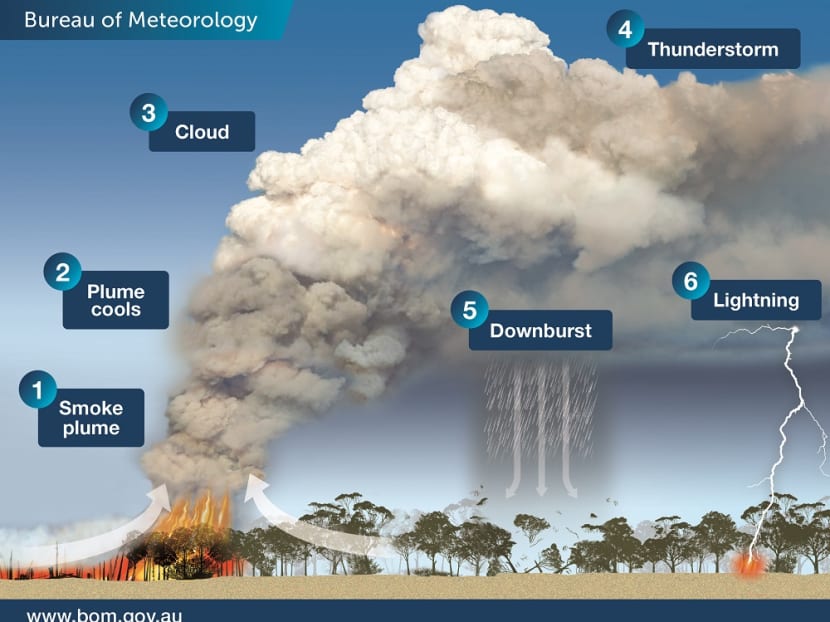Explainer: How Australia’s bushfire smoke has circled the globe, causing dangerous ‘fire clouds’
SINGAPORE - Thunderstorms and extensive rainfall in eastern Australia in recent days may have offered firefighters some respite, but smoke from Australia’s unprecedented bushfires has now circled the globe and is being driven almost 15km into the atmosphere causing dangerous “fire clouds”.

A satellite image of Bateman's Bay in New South Wales, one of a series of wild bushfires that have devastated Australia this summer, taken on Dec 31, 2019.
SINGAPORE - Thunderstorms and extensive rainfall in eastern Australia in recent days may have offered firefighters some respite, but smoke from Australia’s unprecedented bushfires has now circled the globe and is being driven almost 15km into the atmosphere causing dangerous “fire clouds”.
The National Aeronautics and Space Administration (Nasa) in the United States, which has been tracking the smoke, said on Jan 14 that satellite imagery showed the smoke “coming back to the eastern region of Australia after having travelled around the world”.
The smoke smothered New Zealand’s South Island for days, starting on Dec 31 last year, covering its skies with haze and turning mountaintop snow and glaciers brown.
About 9,000 km further east, bushfire smoke was also detected along the heights of South America in Chile and Argentina by the Meteorological Directorate in Santiago, Chile on Jan 7.
However, the smoke has not caused problems for the local population, said the weather monitoring organisation.
Some smoke has also been blown across the Atlantic toward the southern tip of Africa, according to imagery from Nasa.
Nasa is still studying what will eventually happen to the swiftly moving smoke, and how it will continue to affect countries around the world.
TODAY takes a closer look at how smoke from the Australian bushfires can travel all the way across the world.
HOW CAN SMOKE BE BLOWN SO FAR?
The smoke is able to travel such a long distance largely because the bushfires that generated the smoke were so intense — fuelled by one of Australia’s worst droughts in decades and record high temperatures.
The smoke starts entering the atmosphere in a powerful updraft, when massive plumes of smoke and ash are pushed upward by hot rising air.
As the smoke rises, it mixes with cooler air and begins forming what are called pyrocumulonimbus clouds, also known as firestorms or fire clouds.
These rare and dangerous clouds are essentially thunderstorms that move quickly, creating rapid winds and channelling smoke high into the sky like a chimney. They are capable of generating their own weather systems, including lightning strikes.

The way that massive plumes of smoke are funnelled upwards to create pyrocumulonimbus clouds, which can generate their own weather. Illustration: bom.gov.au
Some of these firestorms are so strong that they can carry smoke 15km skywards and into the stratosphere, a section of the atmosphere where wind speeds can reach up to 220 km/h.
It is here that winds start to blow the smoke across oceans and continents.
Scientists are also concerned that the smoke and burning material could linger in the stratosphere and damage the ozone layer inside, affecting the Earth’s climate. The ozone layer serves as an important filter blocking out hazardous ultraviolet radiation from the sun.
Dr David Peterson, a meteorologist at the US Naval Research Laboratory, told The New Scientist that the effect of the firestorms on the ozone layer could be similar to that of a “moderate volcanic eruption”.
“It is likely on a volcanic scale. The big thing here is really the impact that this is having on the stratosphere,” he said.
CAN THE SMOKE REACH SINGAPORE?
For now, it is unlikely that any of the bushfire smoke will come to Singapore, said the Meteorological Service Singapore (MSS).
“Singapore and the surrounding region are currently in the Northeast Monsoon season, which is expected to last until March 2020,” said an MSS spokesperson.
During this period, winds in the region will blow from the north to the south, likely sweeping the smoke away from Singapore when it reaches South-east Asia.
Singapore also does not receive any winds from Australia, even during the Southwest Monsoon season in June, which is when local southerly winds blow through the area, said the MSS.






